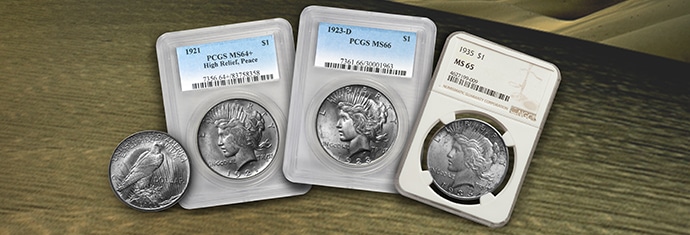Learn About the Legacy of the Great War Silver Peace Dollar
Americans in the 19th century had a love affair with Morgan Silver Dollars. A coalition of farmers, miners and politicians had legislation passed requiring the purchase of two million ounces of silver from Nevada miners in 1878. This led to the striking of millions of Morgan Silver Dollars from 1878 through 1904.
But as the 20th century dawned, the love affair was no more. Paper currency became all the rage and Americans were more comfortable, in a variety of ways, carrying paper bills than carrying dozens of bulky silver dollars.
World War I
The surplus of silver dollars created a hiatus in the striking of these coins from 1905 through 1920. The U.S. entered World War I in 1917, which sped up the demise of Germany and the Central Powers. Late in the war, Germany tried to destabilize Great Britain by convincing the people of India that the British would not be able to redeem all the paper currency it had issued in India. Britain turned to the United States for help.
In 1918, Congress passed the Pittman Act permitting the government to sell Britain up to 350 million silver dollars to help Britain purchase the Indian notes that were being redeemed. This represented 47 percent of all Morgan Dollars that had ever been struck. Now, once again, there was a shortage of American silver dollars.
Post World War I
The U.S. Mint began striking the Morgan Silver Dollars once again in 1921 but there was a public outcry for a new coin – one that would celebrate the end of the “The Great War.” As Morgan Dollars had been struck since 1878, the 25-year minimum threshold had passed so a new design could be requested. A competition was held to find a new design, for the coin that would be known as the Peace Silver Dollar, won by an Italian immigrant named Anthony de Francisci.
The Peace Silver Dollar
The obverse of de Francisci’s design depicted an allegorical portrait of Liberty, facing left. The sculptor used his wife, Teresa, as the model. She had immigrated to the United States in 1905 as a young child and was enthralled by seeing the Statue of Liberty in New York harbor. Her selection to pose as Lady Liberty was the culmination of her dreams.
The remainder of de Francisci’s design proved extremely controversial. The reverse had the obligatory American bald eagle, but the eagle was standing above a broken sword with the word “PEACE” underneath. The broken sword, to many observers, represented a defeated army. The United States had just helped the Allies win World War I. The broken sword was meant to convey the U.S. had vanquished an army but the controversy raged all the same.
After modifications were made to remove the broken sword, the coin was now ready for striking. Like the Saint-Gaudens $20 Gold Double Eagles, the 1921 Peace Dollar was struck in high relief. And, as with the Saint-Gaudens coins, the relief on the Peace Dollar was lowered in subsequent years to improve commerce and stackability.
Peace Dollars were struck at the Philadelphia Mint annually until 1928 and at both the Denver and San Francisco Mints with limited regularity. Minting resumed in 1934 but ended just a year later.
In 1935, the striking of Peace Silver Dollars officially ended as the excess of Morgan and Peace Dollars overflowed the Treasury’s coffers. After a 30-year delay, legislation was passed to issue Peace Silver Dollars again in 1964, but those plans were abandoned, and the 316,000 1964-dated coins struck at the Denver Mint were subsequently melted.
The Peace Silver Dollar’s design is a lasting tribute to the end of the “War to End All Wars.”





